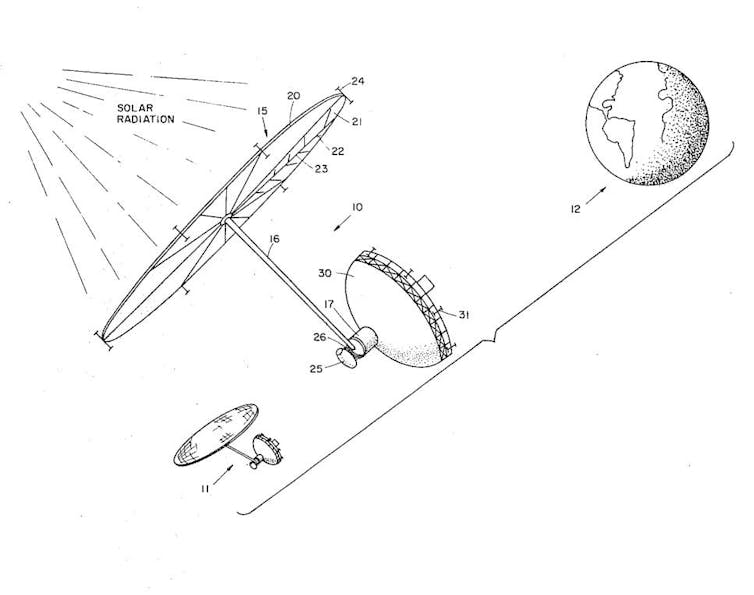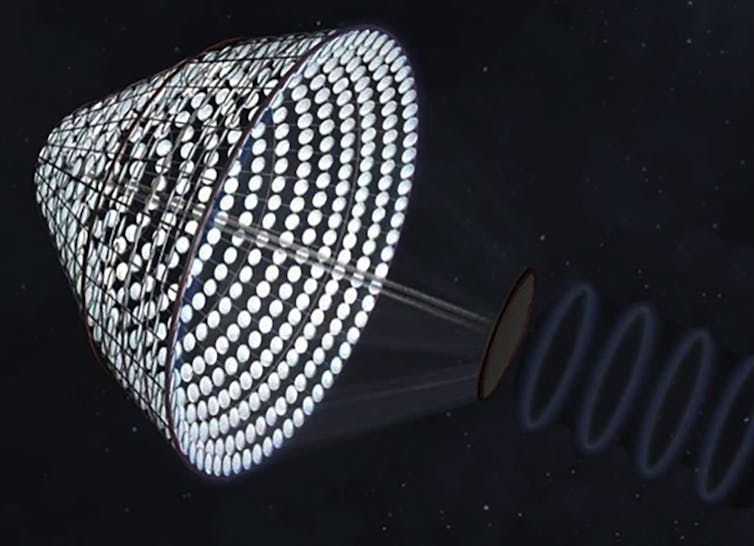
The idea of space-based solar power (SBSP) – using satellites to collect energy from the Sun and "beam" it to collection points on Earth – has been around since at least the late 1960s.
Despite its huge potential, the concept has not gained sufficient traction due to cost and technological hurdles.
Can some of these problems now be solved? If so, SBSP could become a vital part of the world's transition away from fossil fuels to green energy.
We already harvest energy from the Sun. It's collected directly through what we generally call solar power. This comprises different technologies such as photovoltaics (PV) and solar-thermal energy.
The Sun's energy is also gathered indirectly: wind energy is an example of this, because breezes are generated by uneven heating of the atmosphere by the Sun.
But these green forms of power generation have limitations. They take up lots of space on land and are limited by the availability of light and wind. For example, solar farms don't collect energy at night and gather less of it in winter and on cloudy days.
PV in orbit won't be limited by the onset of night. A satellite in geostationary orbit (GEO) – a circular orbit around 36,000 kilometers above the Earth – is exposed to the Sun for more than 99 percent of the time during a whole year. This allows it to produce green energy 24/7.
GEO is ideal for when energy needs to be sent from the spacecraft to an energy collector, or ground station, because satellites here are stationary with respect to the Earth. It's thought that there's 100 times more solar power available from GEO, than the estimated global power demands of humanity by 2050.
Transferring energy collected in space to the ground requires wireless power transmission. Using microwaves for this minimises the energy lost in the atmosphere, even through cloudy skies.
The microwave beam sent by the satellite will be focused towards the ground station, where antennas convert the electromagnetic waves back into electricity. The ground station will need to have a diameter of 5 kilometers, or more at high latitudes.
However, this is still smaller than the areas of land needed to produce the same amount of power using solar or wind.
Evolving concepts
Numerous designs have been proposed since the first concept by Peter Glaser in 1968.
In SBSP, the energy is converted several times (light to electricity to microwaves to electricity), and some of it is lost as heat. In order to inject 2 gigawatts (GW) of power into the grid, about 10 GW of power will need to be collected by the satellite.

A recent concept called Cassiopeia consists of two 2 kilometer-wide, steerable reflectors. These reflect the sunlight into an array of solar panels. These power transmitters, approximately 1,700 meters in diameter, can be pointed at the ground station. It is estimated that the satellite could have a mass of 2,000 tonnes.
Another architecture, SPS-ALPHA, differs from CASSIOPeiA in that the solar collector is a large structure formed by a huge number of small, modular reflectors called heliostats, each of which can be independently moved. They are mass-produced to reduce cost.

In 2023, scientists at Caltech launched MAPLE, a small-scale satellite experiment which beamed a tiny amount of power back to Caltech. MAPLE proved the technology could be used to deliver power to Earth.
National and international interest
SBSP could play a crucial role to meet the UK's net-zero target by 2050 – but the government's current strategy does not include it.
An independent study found that SBSP could generate up to 10GW of electricity by 2050, one-quarter of the UK's current demand. SBSP provides a secure and stable energy supply.
It will also create a multi billion-pound industry, with 143,000 jobs across the country. The European Space Agency is currently evaluating the viability of SBSP with its SOLARIS initiative. This could be followed by a full development plan for the technology by 2025.
Other countries have recently announced the intention to beam power to Earth by 2025, moving to larger systems within the next two decades.
A massive satellite
If the technology is ready, why is SBSP not being used? The main limit is the enormous amount of mass that needs to be launched into space, and its cost per kilogram.
Companies such as SpaceX and Blue Origin are developing heavy-lift launch vehicles, with a focus on reusing parts of those vehicles after they have flown. This can bring the cost of the venture down by 90 percent.
Even using SpaceX's Starship vehicle, which can launch 150 tonnes of cargo into low Earth orbit, the SBSP satellite will require hundreds of launches. Some components, such as long structural trusses – structural elements designed to span long distances – could be 3D-printed in space.
Challenges and risks
An SBSP mission will be challenging – and risks need to be still fully assessed. While the electricity produced is fully green, the impact of the pollution from hundreds of heavy-lift launches is difficult to predict.
Additionally, controlling such a large structure in space will require substantial amounts of fuel, which involves engineers working with sometimes very toxic chemicals. The photovoltaic solar panels will be affected by degradation, reducing efficiency over time by 1 to 10 percent per year. However, servicing and refueling could be used to extend the satellite's lifetime almost indefinitely.
A beam of microwaves powerful enough to reach the ground could also harm anything that got in the way. For safety, then, the power density of the beam will have to be restricted.
The challenge of building platforms like this in space like this may seem daunting, but space-based solar power is technologically feasible. To be economically viable, it requires large-scale engineering, and therefore long-term and decisive commitment from governments and space agencies.
But with all that in place, SBSP could make a fundamental contribution to delivering net zero by 2050 with sustainable, clean energy from space.![]()
Matteo Ceriotti, Senior Lecturer in Space Systems Engineering, University of Glasgow
This article is republished from The Conversation under a Creative Commons license. Read the original article.





No comments:
Post a Comment